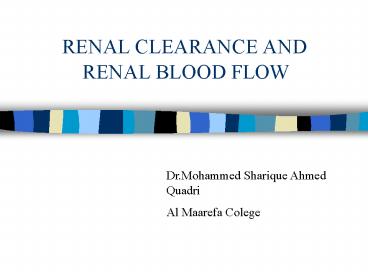RENAL CLEARANCE AND RENAL BLOOD FLOW PowerPoint PPT Presentation
1 / 23
Title: RENAL CLEARANCE AND RENAL BLOOD FLOW
1
RENAL CLEARANCE AND RENAL
BLOOD FLOW
Dr.Mohammed Sharique Ahmed Quadri Al Maarefa
Colege
2
Objective
- Describe the concept of renal plasma clearance
- Use the formula for measuring renal clearance
- Use clearance principles for inulin, creatinine
etc. for determination of GFR - Use PAH clearance for measuring renal blood flow
- Outlines the factors affecting the renal blood
flow .
3
Plasma clearance
- Definition
- Volume of plasma completely cleared of a
particular substance by kidneys per minute - (not the amount of the substance removed)
- Varies for different substances, depending on how
the kidneys handle each substance - Unit- ml/min
4
- EQUATION FOR RENAL CLEARANCE
- Cx (U)x X V
- (P)x
- Where -
- Cx Clearance(ml/min)
- (U)x Urine concentration of the
- substance(mg/ml)
- V Urine flow rate (ml/min)
- (P)x Plasma conc of the substance(mg/ml)
5
(No Transcript)
6
- If substance is filtered , not reabsorbed or
secreted , its plasma clearance rate equals GFR
7
- Clearance of Various Substances
- Albumin 0 normally albumin is not filtered
across the membrane - Glucose 0 normally filtered glucose is
completely reabsorbed back into the blood stream - Inulin is equal to the GFR.(Glomerular Marker)
Inulin is a Fructose polymer freely filtered
across the membrane and neither reabsorbed nor
secreted. - PAH Para Amino Hippuric Acid( other organic
acids).Has highest clearance since it is both
filtered and secreted.
8
(No Transcript)
9
- Clinically it is not convenient to use inline
clearance to maintain a constant plasma
concentration it must be infused continuously
throughout measurement - Creatinine clearance is used as a rough estimate
of GFR
10
- CLEARANCE RATIO
- Clearance of any substance (x) compared with
clearance of Inulin C x (
glomerular marker) - C inulin
- C x 1 (filtered neither reabsorbed nor
secreted) - C inulin
- C x lt 1 (substance is not
filtered/filtered reabsorbed) - C inulin
- C x gt 1 (substance is filtered as well as
secreted ) - C inulin
11
Sample problem
- In a 24hr period, 1.44 L of urine is collected
from a man receiving an infusion of inulin. - In his urine, the inulin is 150mg/ml, and Na
is 200 mEq/L. - In his plasma, the inulin is 1mg/mL, and the
Na is 140mEq/L - What is the clearance ratio for Na, and what is
the significance of its value?
12
Renal plasma flow can be estimated from the
clearance of Para-amminohippuric acid
- (Ficks Principle) The amount of a substance
entering the organ is equal to the amount of
substance leaving it( assuming that substance is
neither synthesisized nor degraded by the organ
). - by measuring the amount of a given substance
taken up per unit of time and dividing this value
by the arteriovenous difference for the substance
across the kidney. - Since the kidney filters plasma, the renal plasma
flow equals the amount of a substance excreted
per unit of time divided by the renal
arteriovenous difference as long as the amount in
the red cells is unaltered during passage through
the kidney. - Any excreted substance can be used if its
concentration in arterial and renal venous plasma
can be measured and if it is not metabolized,
stored, or produced by the kidney and does not
itself affect blood flow.
13
- PAH CLEARANCE
- PAH acid is an organic acid which is almost 90
cleared in 1 circulation through the kidneys
since it is both filtered and secreted by the
tubules. - neither metabolized nor synthesized by the
kidneys. - PAH does not alter the RPF.
- No other organ extracts PAH
- Hence clearance of PAH gives the effective Renal
Plasma Flow (EPRF)
14
Use of PAH Clearance to Estimate Renal Plasma Flow
15
(No Transcript)
16
To Calculate Actual RPF , One Must Correct for
Incomplete Extraction of PAH( extraction ratio)
APAH 1.0
17
- Renal Clearance gives an indication of the
functioning of the kidneys.
18
Name Equation Units
Clearance Ux V Px mL/min
GFR U inulin x V P inulin mL/min
Clearance Ratio C x C inulin None
Effective Renal Plasma Flow U (PAH) x V P (PAH) mL/min
19
- REGULATION OF RENAL BLOOD FLOW
- RBF (Q)
- is directly proportional to the pressure gradient
(?P) between the renal artery and the renal vein - Is inversely proportional to the resistance(R) of
the renal vasculature - (Q) ? P
- R
- The major mechanism of changing Renal blood flow
is by changing Afferent or Efferent Arteriolar
resistance.
20
- 1) SYMPATHETIC NERVES AND CIRCULATING
CATACHOLAMINES - Both afferent and efferent arterioles are
innervated by sympathetic nerves that act via a1
receptors to cause vasoconstriction. - However ,since far more a1 receptors are present
on Afferent arterioles, increased sympathetic
stimulation will cause a decrease in both RBF
GFR.
21
- 2) ANGIOTENSIN II
- This is a potent vasoconstrictor. However
Efferent arteriole is more sensitive to
Angiotensin II. Hence low levels of Angiotensin
II causes increase in GFR while high levels of
Angiotensin II will decrease GFR. RBF is
decreased. - 3) PROSTAGLANDINS
- PGE 2, PGI 2 are produced locally in the
kidneys cause vasodilation of both afferent
efferent arterioles. - This effect is protective for renal blood flow ,
it modulates the vasoconstriction produce by
sympathetic angiotensin-II - 4)DOPAMINE
- At low levels Dopamine dilates Cerebral,
Cardiac, Splanchnic Renal arterioles and
constricts Skeletal Muscle and Cutaneous
arterioles. Hence low dose Dopamine can be used
in the treatment of hemorrhage .
22
- AUTOREGULATION OF RENAL BLOOD FLOW
- Myogenic theory
- 2. Tubuloglomerular feedback by Juxta Glomerular
Apparatus (JGA)
23
References
- Human physiology by Lauralee Sherwood, seventh
edition - Text book of physiology by Linda .s
contanzo,third edition - Text book physiology by Guyton Hall,11th edition

